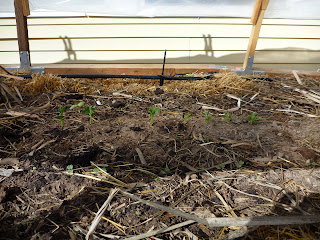Of course, to those of you who don't grow at 7,500 feet in Colorado, that's not big news. Regardless, we're excited that our new raised bed and cold frame seem to be working!
The row of obvious sprouts in the middle are British Wonder peas and Amish Snap peas. In front of them are Bloomsdale spinach, arugula, and Gold Rush lettuce. To the back are Burpee's Golden beets and Lacinato (aka Dino or Tuscany) kale. We only planted this small area because it's so early for us, and to set-up a succession for harvest. We planted these seeds on March 14th. We'll plant some more tomorrow, and we have several other varieties started in seedling cups that'll go into the bed once they and the weather are ready.
In early February we found some old barn wood and rebar scraps to shore-up the sides of the bed. We figure that the straw will break-down over time, and we're not sure that we want the bed to just collapse in all directions. The soil is composed of mostly composted horse manure graciously donated by the monastery up the road from us, clay-rich dirt mined from one of our hillsides, and top soil from our local reclamation/landfill site. We figure the "holy shit" in there will compensate for any deficiencies in the clay or top soil, and just generally raise the spirits of the plants. We didn't finish adding soil until the first week of March. The hoops are constructed of scrap 2x2 and 2x4 found in our wood pile. Unfortunately, this wood is so dry I had to be very careful and pre-drill all screw holes to prevent it from splitting.
We have about 1,000 feet of some plastic that was experimentally used as a ditch liner back in the 1990's. It didn't see much sun, and seems to be in decent shape, so we used it to cover the cold frame. It turns out that it's not the best plastic, and we've been using a bit of duct tape to keep it in one piece. We've found that as long as we don't try to manipulate it while it's frozen, we have much better luck. We'll keep using it until it's gone, but will be installing some wriggle wire bases to ease changing it out. As a side note, the plastic did work as a ditch liner, but wreaked havoc on the small wildlife and the family didn't want to leave it to disintegrate in an otherwise beautiful and remote area in the mountains.
We have found that using spring clamps works well for opening the cold frame to allow ventilation. We installed a micro-sprayer irrigation system, and use cattail mulch to minimize how much we have to use it. Next step may be a timer for the sprinklers. As mentioned earlier, we're putting more seed in the soil tomorrow. Looking forward to seeing the radishes, carrots, thyme, cosmos, four o'clocks, and more lettuce, arugula, and spinach sprout!
~Aaron





No comments:
Post a Comment